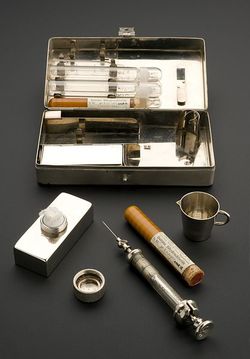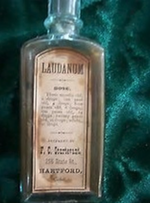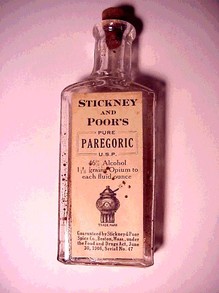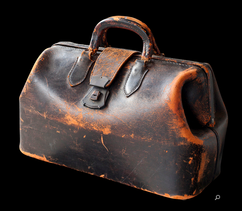For more information abiut any of these instruments go to;
http://www.emsmuseum.org
http://otoscopy.hawkelibrary.com/album09?GS-5
http://ww.thefreedictionary.com/sphygmometer
Next week: A short history of medicine and childbirth.
BLOG
|
You all know what a stethoscope is....the wonderful instrument that allows your doctor or nurse to listen to your heartbeat, but did you know that it will be 200 years old in 2016? It was invented in 1816 by a young French physician named Laennec, who was too embarrassed to put his ear to the chest of a young woman he was examining. So, he rolled up 24 sheets of paper into a tube, put one end on her chest and listened to the other...voila! the stethoscope. The stethoscope shown here is from the 1920's and would be very similar to the one Robert carried in his medical bag. He also carried a sphygomometer. You would know it by its familiar name of blood pressure cuff. it measures the strength and speed of your pulse. Used together, these two instruments provided the doctor with valuable information about your heart health. Another instrument Robert would carry when he visited a patient with an earache was an otoscope. The drawing of a doctor in the late 1800's shows an otoscope very similar to the one Robert would have used when he traveled to Alberta in 1909. Now of course, they are digitized and don't need the reflective mirrors shown in this drawing.
For more information abiut any of these instruments go to; http://www.emsmuseum.org http://otoscopy.hawkelibrary.com/album09?GS-5 http://ww.thefreedictionary.com/sphygmometer Next week: A short history of medicine and childbirth.
0 Comments
Morphine, an opium derivative,is named after the greek god of sleep, Morpheus. A pharmacist's assistant named Werturner developed it in the mid 19th century as an alternative to opium. It was so powerful that physicians reckoned it was 10 times stronger than opium. Not only did it kill pain, it was also accompanied by a feeling of euphoria. However,the side effects, both psychiatric and physical, included confusion, nausea,violent vomiting, constipation, slowed breathing and, in an overdose, death. Doctors very quickly learned that it was highly addictive, more so even than opium, but it was, and still is, a great painkiller. So it was used with caution... and became an important tool in the medical toolkit. And it became even more important when the hypodermic needle was perfected in 1853. Robert would definitely carry a syringe set and soluble morphine in his medical bag. And what about heroin? It is interesting to read advertisements from 1902. Remember Bayer aspirin? Bayer and other companies also marketed heroin tablets for cough suppression.  Heroin is also extracted from the seed pod of the Asian poppy. It converts to morphine in the brain and is extremely addictive. it binds to receptors in the brain stem which control automatic processes such as blood pressure and breathing. Along with opium, it was marketed for asthma and cough suppression. Doctors of the era would probably carry a bottle of Fraser's Tablets, a compound of heroin in tablet form , for use in a severe asthma attack. By Robert's time, they had realized that such medication must be used sparingly. No one of course fully understood the pathology of addiction, but wise physicians saw the dreadful consequences of opiate use, especially after the first World War. See 1902 advertisement below To learn more about morphine and heroin, go to: http:wings.buffalo.edu/aru/preprohibition.htm Next week: Some more of the instruments in Robert's medical bag.  In Victorian times (Queen Victoria died in 1901) laudanum was a popular painkiller and cough suppressant. A drink of laudanum, a solution of 10% opium and 90% alcohol flavoured with cinnamon or saffron, was often prescribed for coughs, or for "female troubles", from migraine to severe headaches to something called female "hysteria". I'll bet you felt better after a dose of that! Robert would probably not carry laudanum in his bag as it was available without prescription in most pharmacies in the early 1900's. Opium itself has been known as a pain killer for centuries, and its highly addictive properties were often ignored when a powerful painkiller was required. It is important to remember that while physicians and surgeons knew that opium was effective as a painkiller, they did not know why it worked. The mechanisms of the brain and its receptors for opiates were simply not understood. Unfortunately laudanum was also used by those who were not in pain as it was easily available in what were called Opium dens..but, I digress.  Physicians also prescribed other opium/alcohol compounds called paregorics. These had a far lower quantity of opium and the dosages were usually diluted in water. So, there would be a small bottle of some paregoric in Robert's bag as a painkiller. More effective than aspirin but less powerful than laudanum. And certainly less addictive than next week's topic..morphine and heroin.  When asked in his later years what he had carried with him in his medical bag to Alberta in 1909, T. Robert Ross always smiled as he joked, "You mean in addition to my bone saw? Well, a bottle of aspirin and a sharp scalpel." And this was very nearly true. Many of the medical marvels we take for granted today, from pain killers to antibiotics either did not exist or were not easily available to the medical profession. So what was in that medical bag? Let's start with an ordinary medicine most of us have in our medicine cabinets, aspirin. In it's familiar form it has not been around forever. While infusions of willow bark have been used as painkillers by indigenous people and folk healers for centuries, the mixture was terribly irritating to the stomach. ASPIRIN, the Bayer trademark for an acetyl salicylic acid compound was developed in something like its present form just before the turn of the last century. In 1899 Felix Hoffman added an acetyl group compound to salicylic acid (from willow bark) to reduce its irritant properties. By 1900 it was a familiar tool in the medical tool box. Aspirin is probably the least harmful of the painkillers used at that time and on to the present day. Of course, Robert had other pain killers in his doctors bag. What about a painkiller for surgery? Aspirin just wouldn't cut it, so to speak. Next time, heavy duty painkillers from previous decades. And this is scary stuff!! Stay tuned for laudanum. Learn more at http://www.aspirin-foundation.com |
Archives
October 2023
Categories |